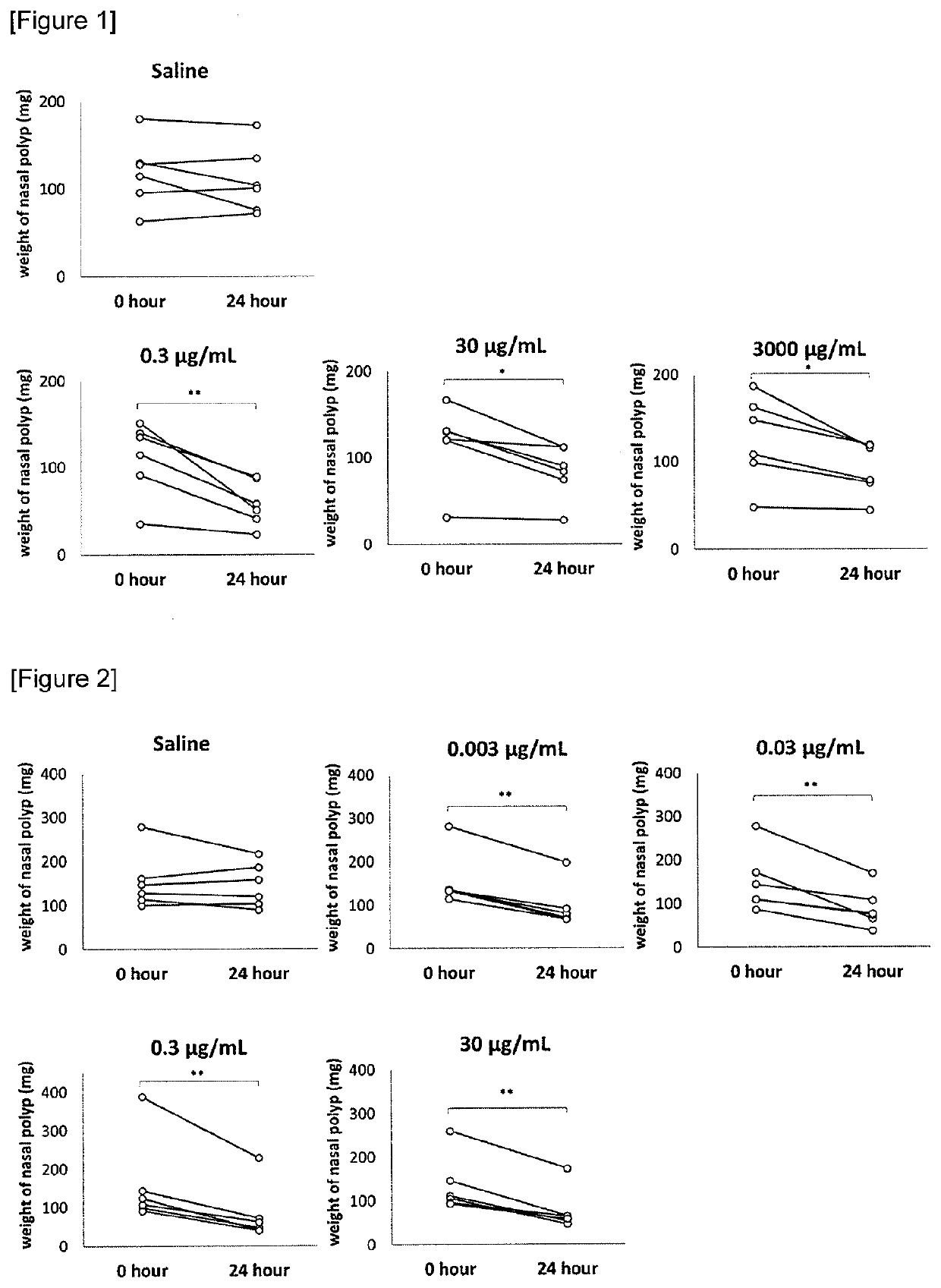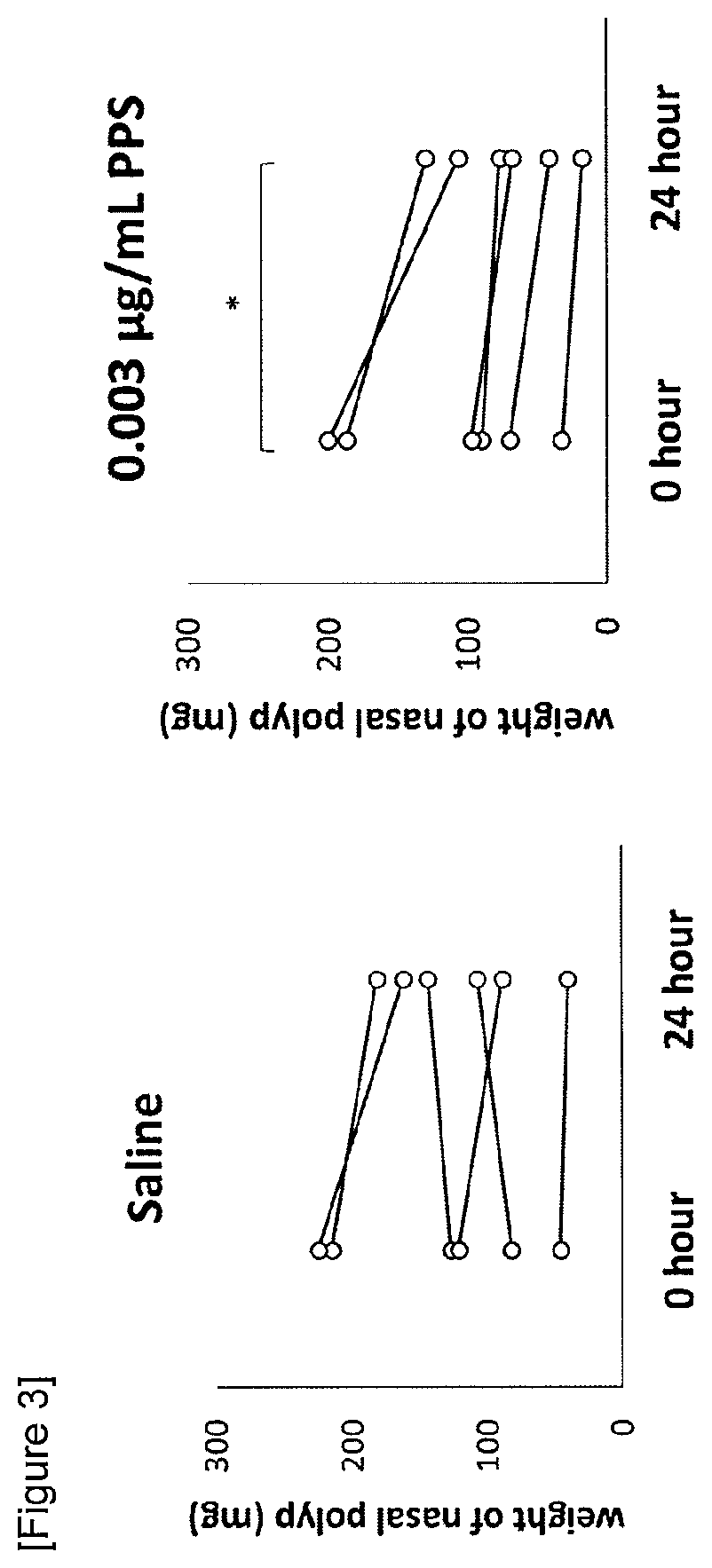Pharmaceutical composition
a technology of pharmaceutical compositions and compositions, applied in the field of pharmaceutical compositions, can solve the problems of ineffective antibacterial drugs for treating diseases and troublesome nasal polyp regeneration, and achieve the effect of safe nasal polyp reduction
- Summary
- Abstract
- Description
- Claims
- Application Information
AI Technical Summary
Benefits of technology
Problems solved by technology
Method used
Image
Examples
example 1
[Example 1] the Reduction Effect of Heparinoid on Nasal Polyps from Patient with Eosinophilic Sinusitis
[0186]A heparinoid (organic sulfate group 25.8 to 37.3% w / w, D-glucuronic acid 19.0 to 24.0% w / w, Maruho Co., Ltd.) dried under reduced pressure was dissolved in saline to prepare heparinoid solutions (0.3, 30 and 3,000 μg / mL). A nasal polyps specimen was surgically obtained from a patient with eosinophilic sinusitis, cut into pieces of about 5 mm squares, wiped off the moisture and measured the weight. Each specimen was transferred to a 12-well plate. The specimen in the plate was incubated with 1 mL of saline or heparinoid solutions at 37° C. for about 24 hours. Then, after wiping off the moisture in the incubated specimen taken from the plate, the weight of the specimen was measured. The difference between specimen weights before and after incubation was used as an index of a nasal polyps reduction effect. The saline group and heparinoid solution groups (different in concentrati...
example 2
[Example 2] the Reduction Effect of Heparinoid on Nasal Polyps from Patient with Eosinophilic Sinusitis
[0188]The reduction effects of heparinoid solutions (0.003, 0.03, 0.3 and 30 μg / mL) on nasal polyps were evaluated in the same method as in Example 1. The saline group and heparinoid solution groups (different in concentration) of FIG. 2 each consisted of 6 cases.
[0189]Changes in specimen weight before and after the incubation are shown in FIG. 2. In FIG. 2, symbol ** represents significant difference (** P<0.01) of nasal polyps weight before and after the incubation by a paired t-test. The weight of the nasal polyps incubated with saline was not changed significantly, whereas the weight of the nasal polyps incubated with heparinoid solutions (0.003, 0.03, 0.3 and 30 μg / mL) was decreased significantly. From the results, it was suggested that the heparinoid has a reduction effect on nasal polyps.
example 3
[Example 3] the Reduction Effect of Pentosan Polysulfate (PPS) on Nasal Polyps from Patient with Eosinophilic Sinusitis
[0190]A PPS solution (0.003 μg / mL) was prepared and the reduction effect on nasal polyps was evaluated in the same method as in Example 1. PPS used herein was sodium pentosan polysulfate (weight average molecular weight 4,000 to 6,500, sulfur content 13.0 to 20.0% w / w, glucuronic acid content 2.5 to 4.0% w / w) manufactured by Molclone Labs. The saline group and PPS solution group of FIG. 3 each consisted of 6 cases.
[0191]Changes in specimen weight before and after the incubation are shown in FIG. 3. The weight of the nasal polyps incubated with saline was not changed significantly, whereas the weight of the nasal polyps incubated with 0.003 μg / mL PPS solution was decreased significantly. From the results, it was suggested that the PPS has a reduction effect on nasal polyps in patients with eosinophilic sinusitis.
PUM
| Property | Measurement | Unit |
|---|---|---|
| flow rate | aaaaa | aaaaa |
| temperature | aaaaa | aaaaa |
| pharmaceutical composition | aaaaa | aaaaa |
Abstract
Description
Claims
Application Information
 Login to View More
Login to View More - R&D
- Intellectual Property
- Life Sciences
- Materials
- Tech Scout
- Unparalleled Data Quality
- Higher Quality Content
- 60% Fewer Hallucinations
Browse by: Latest US Patents, China's latest patents, Technical Efficacy Thesaurus, Application Domain, Technology Topic, Popular Technical Reports.
© 2025 PatSnap. All rights reserved.Legal|Privacy policy|Modern Slavery Act Transparency Statement|Sitemap|About US| Contact US: help@patsnap.com


